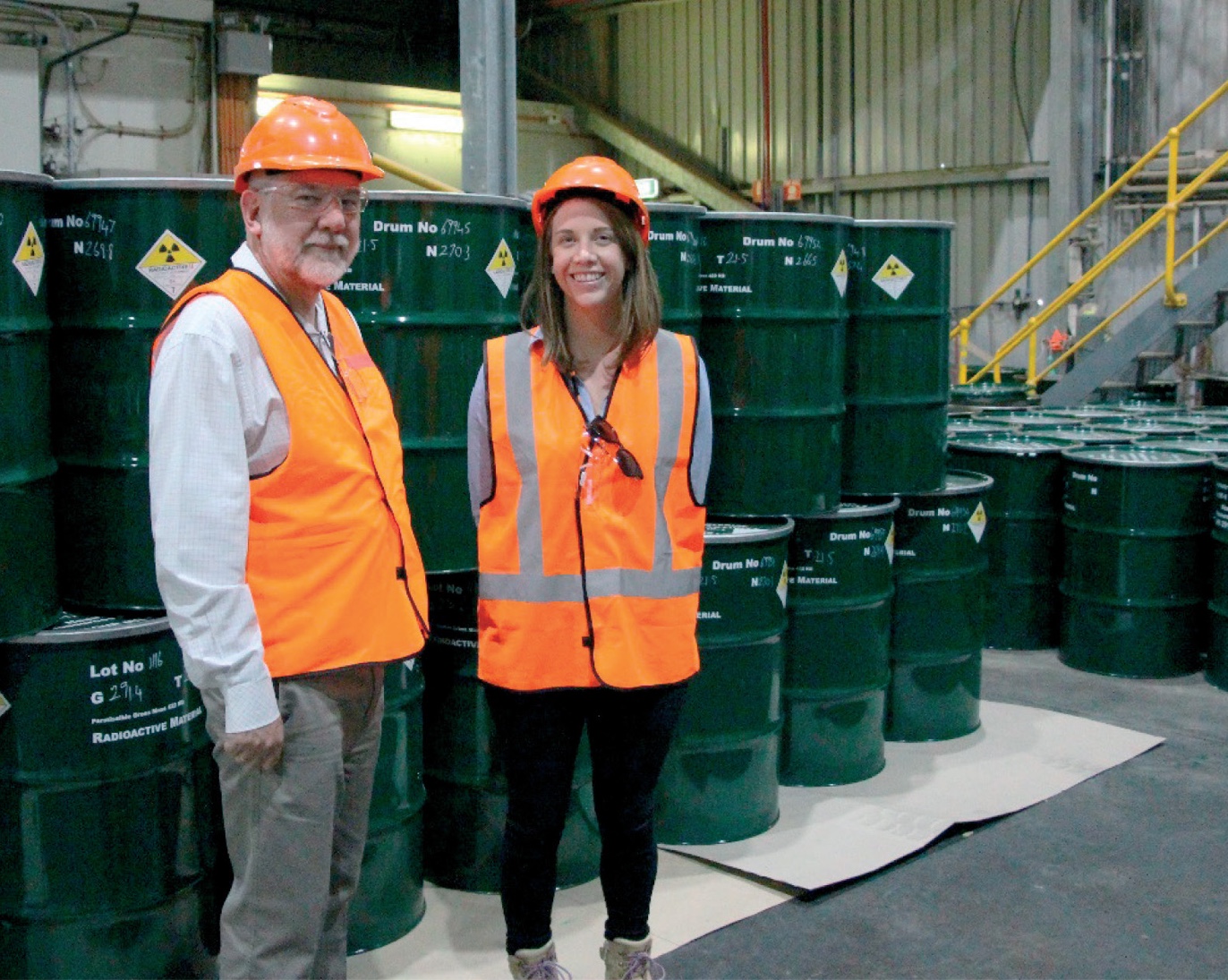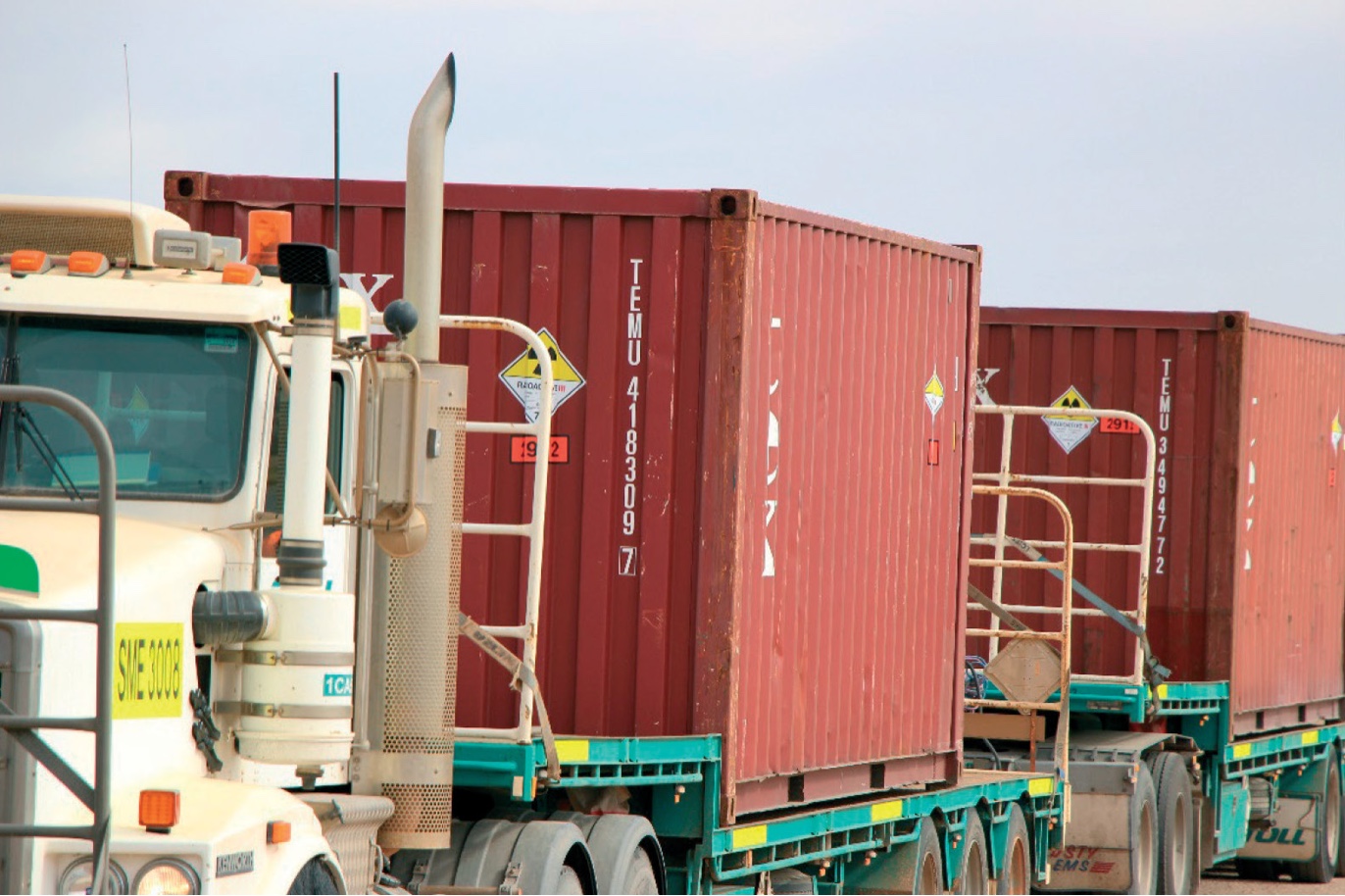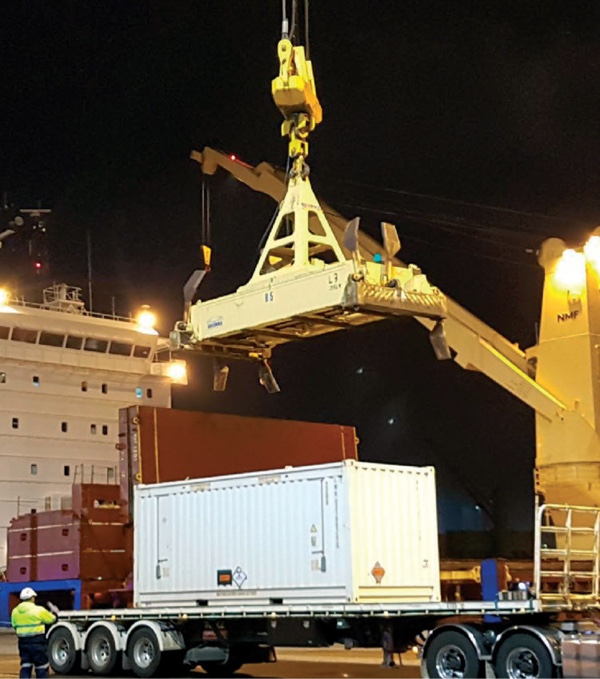Output 1.2: Nuclear Security
Protection of Australia's nuclear facilities, nuclear material and nuclear items against unauthorised access removal and sabotage, including Australia's uranium supplied overseas.
Performance Measures
- Security of nuclear material, technology and facilities meets Australia's obligations under the Amended Convention on the Physical Protection of Nuclear Material (A/CPPNM), the International Convention for the Suppression of Acts of Nuclear Terrorism and bilateral nuclear cooperation agreements, as well as being in accordance with IAEA guidelines.
- Internationally agreed standards for the security of nuclear material are applied to all AONM.
- Proactive and professional contributions are made to the development and effective implementation of nuclear security worldwide.
Performance Assessment
Australian Nuclear Material Categories
The table below lists the permit holders for which physical protection or information security is required, categorised according to the materials or items held.
| Nuclear Material Category | Type of ‘Facility' | Number of Permit Holders |
|---|---|---|
| Category II25 | Research Reactor, Storage | 1 |
| Category III | Storage, Scientific Research | 1 |
| Category IV26 | Scientific Research | 1 |
| Uncategorised27 | LOFs | 97 |
| Natural Uranium (UOC) | Uranium Mines and Concentration Plants | 4 |
| Transport of nuclear material | Transport Companies, Ports, Shipping Lines | 25 |
| Associated Items | ||
| Associated Equipment and Technology | Enrichment Research, Storage and Archives | 4 |
| Associated Technology | Patent Attorneys | 3 |
International and Bilateral Obligations
ASNO's regulation of permit holders established that security arrangements at Australian nuclear facilities were in accordance with Australia's obligations under the CPPNM, its 2005 Amendment and relevant bilateral nuclear cooperation agreements, as well as being in accordance with IAEA recommendations. ASNO also met Australia's international shipment notification obligations under the CPPNM by notifying relevant parties of the transhipment of uranium ore concentrates (UOC) exported from Australia.
Exports of Australian Uranium
Transport of all Australian UOC to destinations abroad is done in accordance with new model transport permit requirements that include verifying the integrity of containers holding UOC. Container seals are checked at each port of unloading or transhipment to detect any breaches of integrity. There were no security incidents (malicious acts) involving the transport of UOC in Australia during the reporting period.
In October 2018, two (of twenty) containers, from a shipment of Australian UOC, were opened at a conversion facility finding snapped or loose cargo strapping used to tie-down UOC drums. This allowed for movement of a few drums within these containers. After unloading, damage to a single drum of UOC was identified. A small amount of UOC leaked from the damaged drum but was retained within the container ensuring full recovery of UOC. Subsequent investigation could not conclusively determine the initiating event for the strapping failure.
Nuclear Security of UOC at Australian Mines and in Transport
On 17 September 2018, ASNO conducted an inspection at the Olympic Dam uranium mine. The purpose of the inspection was to verify that the requirements of their Permit to Possess Nuclear Material are met and that the performance of physical protection and material accountancy systems are adequate. As part of the inspection ASNO reviewed changes to transport arrangements, security measures in the uranium production plant, computer security and contracted security arrangements. ASNO conducted an inspection of the Beverley Uranium Mine on 21 March 2019. The inspection included evaluating draft revisions of security plans and procedures against ASNO's permit requirements. This inspection included changes to plant, performance of physical protection, material accountancy and future expansion including a new pipeline installed directly from the Four Mile West tenement to the Beverley Plant. For both facility inspections, ASNO concluded that BHP and Heathgate continue to meet permit conditions related to security and accountancy to satisfactory levels.

ASNO Inspectors at the Beverley Uranium Mine of Heathgate Resources
The physical protection of UOC in transport extends from mine to port and in keeping with ASNO's outreach and engagement activities, a scheduled inspection conducted on 18 September 2018 of a transport company included being a passenger during conveyance of UOC from mine to port. ASNO observed that security procedures were correctly implemented by the carrier.
On 19 September 2018 and 20 March 2019, ASNO inspectors conducted follow-up inspections of a storage compound for UOC incidental to transport. ASNO approved the completed installation of physical protection measures and updated transport security plans. On 20 March 2019 ASNO also conducted an inspection of an alternate interim storage location for the carrier at Flinders Port.
Nuclear Security at Lucas Heights
As part of the OPAL reactor regulatory licencing requirements, ANSTO will submit a periodic safety and security review (PSSR) to the CEO of ARPANSA and to the Director General of ASNO. The integrated PSSR is an Australian leading first for research reactors worldwide. The PSSR examines all individual aspects and synergies of security and safety factors in place for the OPAL reactor, following relevant ARPANSA and ASNO regulatory requirements. Launched in March 2018, the PSSR is a large scope of work, which draws on current international best practice.
The new ANSTO Nuclear Medicine (ANM) facility commenced routine production that opens the way for Australia to supply a very significant proportion of the growing world market for nuclear medicine. ASNO worked with ARPANSA to approve ANSTO's security measures, benefitting from the recent follow-up IPPAS mission.

ASNO carried out an inspection of UOC transport operations in September 2018

Spent fuel from an ANSTO research reactor being loaded onto the vessel destined for France.
Shipment of Spent Fuel from the OPAL Reactor
On the evening of 28 July 2018, ANSTO working closely with several State and Federal Government agencies, executed a model example for transport of OPAL spent fuel assemblies to France for reprocessing. This was Australia's 10th routine transport of spent nuclear fuel assemblies. ASNO's involvement included approving the transport plan, granting transfer approvals under three nuclear cooperation agreements and giving prior notice to the IAEA. A subsequent debriefing session highlighted areas where arrangements for future shipments could be further improved.
Other holders of nuclear material
The consolidation of CSIRO's nuclear material holdings has required additional physical protection measures to be installed at an allocated storage facility. ASNO conducted an inspection of the protective security measures and found the storage arrangements to be satisfactory.
SILEX Enrichment Technology
ASNO conducted several routine inspections at Silex Systems Limited (SSL) during the reporting period, including 9 October 2018, 15 February 2019 and 19 June 2019 concentrating on matters raised in SSL's monthly security reports. ASNO provided regulatory oversight of change management of security matters related to personnel restructuring and changes to physical protection measures. No significant security deficiencies were found during the inspections.
SSL is working towards finalisation of a purchase agreement for the restructure of SILEX technology licensee GE-Hitachi Global Laser Enrichment LLC (GLE). This follows the signing of a Term Sheet on 5 February 2019. SSL continues to hold a permit to possess associated technology with ASNO and regulatory activities will be reviewed based on the future disposition of the technology in USA and Australia.
Other Enrichment Technologies
ASNO has issued a Permit to possess associated technology for a developing innovation into uranium enrichment. ASNO is working with the permit holder to apply nuclear security measures on a graded and risk based approach while providing appropriate training.
South Australian UOC Transport Working Group
The South Australia UOC Transport Working Group and a Transport Steering Committee have finalised a number of key outcomes such as:
- the Uranium Oxide Concentrate (UOC) Incident Communications Protocol/Guideline
- the UOC Transport Management Plan Template
- an Incident Response Resource Table and
- an Overview of Consignor and Carrier Requirements for Safe Transport of Radioactive Material in South Australia.
These resources assist oversight by detailing the available capabilities of the mining industry, transporters and emergency services. ASNO contributed transport security expertise to the working group and the steering committee convened by the South Australian Environment Protection Authority (EPA) and attended by State Government, industry and first responders.
An import activity of the Working Group was the conduct, on 23 August 2018, of an Incident Management Desktop Exercise by State and Federal Government, industry, South Australia Police and first responders. The exercise ‘Rocky River 2' was designed to discuss, develop and define consequence management arrangements in the event of a UOC spill in the Mid-North area of South Australia.
Regional Training Course – Introduction to nuclear forensics
In building ASNO's capacity in nuclear forensics, ASNO attended an IAEA Regional Training Course on nuclear forensics held in Sydney, hosted by ANSTO on 25 February – 01 March 2019. The training and exercises were designed to further awareness of analytical measurement techniques and procedures that can support a national response plan to nuclear incidents, to introduce current scientific methods for nuclear forensic analysis, and learn from internationally recognised experts.

Some of the participants at the IAEA Regional Training Course on nuclear forensics using equipment in an ANSTO laboratory
IAEA Consultancy Meetings
ASNO provided expert advice at two consultancy meetings in May 2019; firstly to review an IAEA acquisition path analysis for the development and deployment of an undeclared gas centrifuge enrichment plant (GCEP) for HEU production, and secondly to revise, enhance and improve the IAEA's Physical Model on uranium enrichment in order to further understand the technology, possible diversion paths, proliferation indicators, and emerging issues.
AusIMM
ASNO attended the Australasian Institute of Mining and Metallurgy (AusIMM) International Uranium Conference in Adelaide on 4–5 June 2019. The AusIMM uranium conference was an excellent opportunity to engage with uranium exploration companies and prospective uranium miners who do not yet have a formal regulatory relationship with ASNO, but may in the future require a permit.
Uranium Council Meeting
ASNO attended the annual Uranium Council meeting held in Adelaide on 6 June 2019. The meeting provides a forum for stakeholders (federal and state regulators and industry) to present on contemporary challenges as well as providing updated information of current developments in this field. The meeting sought to update and complete a number of fact sheets relating to Australia's export of UOC.
Preparation for the Conference of States Parties to the Amended CPPNM
In preparation for the Conference of States Parties to the Amended Convention on the Physical Protection of Nuclear Material, mandated under Article 16 of the Convention to take place in 2021, an informal meeting of States Parties was held in December 2018. The meeting developed a provisional roadmap to the Conference, which included a meeting of legal and technical experts and a preparatory committee to establish thematic and procedural matters for the Conference itself. In June 2019, DG ASNO accepted an invitation to co-chair with Argentina the Meeting of Legal and Technical Experts, to take place 22 to 26 July 2019 and to also co-chair with Hungary the Preparatory Committee in 2020. The 2021 Conference will be co-chaired by Switzerland and Nigeria.
Nuclear Security Guidance Committee (NSGC)
The core role of the NSGC is to manage the production of guidance documents in the IAEA Nuclear Security Series (NSS). The NSGC comprises over 50 IAEA member states, is constituted on rolling three-year terms and meets twice per year at the IAEA in Vienna (i.e. six meetings per term). Australia (ASNO) has been a member since its inception in 2012. Director, Nuclear Security (Dr Stephan Bayer) took up the Chair of the NSGC's third term in 2018. The 14th meeting of the NSGC, held in December 2018, concentrated on setting up a review of the top-tier documents of the Nuclear Security Series, approving the publication of a Nuclear Security Series Glossary and discussing the merits of a Nuclear Security Series publication on safety/security interfaces.
Integrated Regulatory Review Service (IRRS)
In November 2018, ASNO participated in an IAEA IRRS mission hosted by ARPANSA. The mission reviewed Australia's national, legal and governmental framework for nuclear and radiation safety against the IAEA's Safety Standards. Of interest to ASNO, mission also addressed the interface between nuclear safety and nuclear security, ASNO's cooperation with ARPANSA on nuclear regulatory matters and ASNO's role in accounting for Australia's holding of nuclear material. The mission report can be found on ARPANSA's web-site.
Post Nuclear Security Summit Activities
Australia is a member of the post-Nuclear Security Summit Nuclear Security Contact Group (NSCG), whose Statement of Principles28 includes advancing implementation of nuclear security commitments and building a strengthened, sustainable and comprehensive global nuclear security architecture. The NSCG, currently chaired by Hungary, met in Vienna and Budapest during the reporting period to discuss collective commitments, core messaging on nuclear security as well as recent and upcoming nuclear security conferences. DG ASNO is Australia's NSCG designate. Australia continued leading a discussion on preparing for the Amended CPPNM review conference which is mandated to take place in 2021.
In further initiatives to promote nuclear security internationally, DG ASNO continues to be active in track 1.5 dialogues, in particular the Nuclear Threat Initiative's Global Dialogue on Nuclear Security Priorities, which like the NSCG, has been active in promoting the Nuclear Security Summits' goals and commitments.
25 Nuclear material category is based on IAEA Nuclear Security Series No. 13
26 Category IV limits are 15g≥Pu>10g; 15g ≥(235U≥20%)>10g; 1000g ≥(235U<20%-10%)>10g; 10 000g ≥(235U<10%)>10g; 15g ≥233U>10g; Unirradiated Source Material ≤5000kg. (%-enrichment)
27 i.e. below Category IV quantities
28 https://www.iaea.org/sites/default/files/publications/documents/infcircs/2016/infcirc899.pdf

